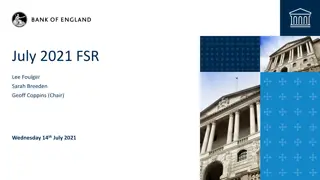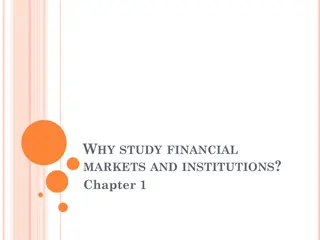Overview of Indian Financial System and Markets
The Indian financial system plays a crucial role in the country's economy by facilitating the efficient allocation of resources. It encompasses various institutions, markets, and instruments that enable the smooth functioning of financial transactions. Understanding the meaning and functions of the financial system is essential for grasping its significance in driving economic growth and development.
Download Presentation

Please find below an Image/Link to download the presentation.
The content on the website is provided AS IS for your information and personal use only. It may not be sold, licensed, or shared on other websites without obtaining consent from the author. Download presentation by click this link. If you encounter any issues during the download, it is possible that the publisher has removed the file from their server.
E N D
Presentation Transcript
FINANCIAL MARKETS SYBBI SEMESTER-III Academic Year-20-21
MODULES INDIAN FINANCIAL SYSTEM FINANCIAL MARKETS IN INDIA COMMODITY MARKET DERIVATIVES MARKET
INDIAN FINANCIAL SYSTEM A) Introduction, Meaning, Functions of financial system, Indian financial system from financial neutrality to financial activism and from financial volatility to financial stability, Role of Government in financial development B) Structure of Indian Financial System Banking & Non-Banking Financial Institutions, Organized and Unorganized Financial Markets, Financial Assets/Instruments, Fund based & Fee Based Financial Services.
OVERVIEW AND STRUCTURE OF INDIAN FINANCIAL SYSTEM The financial system enables lenders and borrowers to exchange funds. India has a financial system that is controlled by independent regulators in the sectors of insurance, banking, capital markets and various services sectors. The financial system of an economy provides the way to collect money from the people who have it and distribute it to those who can use it best. So, the efficient allocation of economic resources is achieved by a financial system that distributes money to those people and for those purposes that will yield the best returns.
The financial system is composed of the products and services provided by financial institutions, which includes banks, insurance companies, pension funds, organized exchanges, and the many other companies that serve to facilitate economic transactions. Virtually all economic transactions are effected by one or more of these financial institutions. They create financial instruments, such as stocks and bonds, pay interest on deposits, lend money to creditworthy borrowers, and create and maintain the payment systems of modern economies.
OBJECTIVES These financial products and services are based on the following fundamental objectives of any modern financial system: I. To provide a payment system II. To give time value to money III. To offer products and services to reduce financial risk or to compensate risk-taking for desirable objectives IV. To collect and disperse information that allows the most efficient allocation of economic resources V. To create and maintain financial markets that provide prices, which indicates how well investments are performing, determines the subsequent allocation of resources, and to maintain economic stability in the markets
FUNCTIONS AND ROLE OF FINANCIAL SYSTEM 1. Pooling of Funds 2. Capital Formation 3. Facilitates Payment 4. Provides Liquidity 5. Short and Long Term Needs 6. Risk Function 7. Better Decisions 8. Finances Government Needs 9. Economic Development
1.Pooling of Funds In a financial system, the Savings of people are transferred from households to business organizations. With these production increases and better goods are manufactured, which increases the standard of living of people. 2. Capital Formation Business require finance. These are made available through banks, households and different financial institutions. They mobilize savings which leads to Capital Formation. 3. Facilitates Payment The financial system offers convenient modes of payment for goods and services. New methods of payments like credit cards, debit cards, cheques, etc. facilitates quick and easy transactions. 4. Provides Liquidity In financial system, liquidity means the ability to convert into cash. The financial market provides the investors the opportunity to liquidate their investments, which are in instruments like shares, debentures, bonds, etc. Price is determined on the daily basis according to the operations of the market force of demand and supply. 5. Short and Long Term Needs The financial market takes into account the various needs of different individuals and organizations. This facilitates optimum use of finances for productive purposes.
6. Risk Function The financial markets provide protection against life, health and income risks. Risk Management is an essential component of a growing economy. 7. Better Decisions Financial Markets provide information about the market and various financial assets. This helps the investors to compare different investment options and choose the best one. It helps in decision making in choosing portfolio allocations of their wealth. 8. Finances Government Needs Government needs huge amount of money for the development of defense infrastructure. It also requires finance for social welfare activities, public health, education, etc. This is supplied to them by financial markets. 9. Economic Development India is a mixed economy. The Government intervenes in the financial system to influence macro-economic variables like interest rate or inflation. Thus, credits can be made available to corporate at a cheaper rate. This leads to economic development of the nation.
MONEY MARKET The money market refers to trading in short-term debt investments. At the wholesale level, it involves large-volume trades between institutions and traders. At the retail level, it includes money market mutual funds bought by individual investors and money market accounts customers. In all of these cases, the money market is characterized by a high degree of safety and relatively low rates of return. opened by bank
The money market involves the purchase and sale of large volumes of very short-term debt products, such as overnight reserves or commercial paper. An individual may invest in the money market by purchasing a money market mutual fund, buying a Treasury bill, or opening a money market account at a bank. Money market investments are characterized by safety and liquidity, with money market fund shares
The money market is one of the pillars of the global financial system. It involves overnight swaps of vast amounts of money between banks and the government. The majority of money market transactions are wholesale transactions that take place between financial institutions and companies. Institutions that participate in the money market include banks that lend to one another and to large companies and time deposit markets. Some of those wholesale transactions eventually make their way into the hands of consumers as components of money market mutual funds and other investments.
CAPITAL MARKET Capital markets are venues where savings and investments are channeled between the suppliers who have capital and those who are in need of capital. The entities that have capital include retail and institutional investors while those who seek capital are businesses, governments, and people. Capital markets are composed of primary and secondary markets. The most common capital markets are the stock market and the bond market.
Capital markets refer to the places where savings and investments are moved between suppliers of capital and those who are in need of capital. Capital markets consist of the primary market, where new securities are issued and sold, and the secondary market, where already-issued securities are traded between investors. The most common capital markets are the stock market and the bond market.
These venues may include the stock market, the bond market, and the currency and foreign exchange markets. Most markets are concentrated in major financial centers like NSE BSE, Commodities exchanges Capital markets are composed of the suppliers and users of funds. Suppliers include households and the institutions serving them pension funds, life insurance companies, charitable foundations, and non- financial companies that generate cash beyond their needs for investment.
Capital markets are used to sell financial products such as equities and debt securities. Equities are stocks, which are ownership shares in a company. Debt securities, such as bonds, These markets are divided into two different categories: Primary markets where new equity stock and bond issues are sold to investors Secondary markets- which trade existing securities.
FUNCTIONS OF FINANCIAL SYSTEM Saving Function Wealth function Liquidity function Transferring resources across time and space Economic development Payment function Risk function
AGENCIES PROVIDING OF FINANCIAL SERVIES Banks Insurance Mutual Funds Merchant banking Venture capital Factoring Forfeiting
FUND BASED SERVICES LEASING HIRE PURCHASE VENTURE CAPITAL SEED CAPITAL FACTORING FORFAITING CREDIT FINANCANCING HOUSING FINANCE MUTUAL FUND
NON-FUND BASED ACTIVITIES(FEES BASED ACTIVITIES) MERCHANT BANKING CREDIT RATING LOAN SYNDICATION PORTFOLIO MANAGEMENT MERGER AND ACQUISITION STOCK BROKING CUSTODIAN SERVICES CAPITAL RESTRUCTURING ISSUE MANAGEMENT
CHALLENGES FACED BY FINANCIAL SERVICE INDUSTRY Increasing competition Regulatory compliance Cultural shift Changing business models Rising expectation Customer retention Changing technology Continuous innovation Sensitive customer
FINANCIAL INNOVATION Financial innovation is the process of creating new financial products, services, or processes. Financial innovation has come via advances over time in financial instruments and payment systems used in the lending and borrowing of funds. These changes which include updates in technology, risk transfer, and equity generation have increased available credit for borrowers and given banks new and less costly ways to raise equity capital. and credit
Financial innovation is the act of creating new financial instruments as well as new financial technologies, institutions, and markets. Recent financial innovations include hedge funds, private equity, structured products, exchange-traded funds. The shadow banking system has spawned an array of financial including mortgage-backed securities products and collateralized debt obligations (CDOs). derivatives, retail- innovations
There institutional, product, and process. Institutional innovations relate to the creation of new types of financial firms such as specialist credit card firms like Capital One, electronic trading platforms. Product innovation relates to new products such as derivatives, securitization, currency mortgages. Process innovations relate to new ways of doing financial business, banking and telephone banking. are 3 categories of innovation: and foreign including online
TYPES OF FINANCIAL INNOVATION Financial system /Institutional Innovation Process Innovation Product Innovation
CHARACTERISTICS OF FINANCIAL SERVICES Intangibility Customer orientation Inseparability Perishability Dynamics
CHAPTER 2 FINANCIAL MARKETS AND REGULATORY FRAMWORK Classification of Financial Markets Organized Market Unorganized Market Capital Market Money Market Primary Market Secondary Market
MONEY MARKET INSTRUMENTS Promissory Note: A promissory note is one of the earliest type of bills. It is a financial instrument with a written promise by one party, to pay to another party, a definite sum of money by demand or at a specified future date, although it falls in due for payment after 90 days within three days of grace. Bills of exchange or commercial bills The bills of exchange can be compared to the promissory note; besides it is drawn by the creditor and is accepted by the bank of the debater. The bill of exchange can be discounted by the creditor with a bank or a broker. Additionally, there is a foreign bill of exchange which becomes due for payment from the date of acceptance. However, the remaining procedure is the same for the internal bills of exchange.
Treasury Bills (T-Bills) The Treasury bills are issued by the Central Government and known to be one of the safest money market instruments available. Besides, they carry zero risk, so the returns are not attractive. Also, they come with different maturity periods like 1 year, 6 months or 3 months and are also circulated by primary and secondary markets. The central government issues them at a lesser price than their face-value. The difference of maturity value of the instrument and the buying price of the bill, which is decided with the help of bidding done via auctions, is basically the interest earned by the buyer. There are three types of treasury bills issued by the Government of India currently that is through auctions which are 91-day, 182-day and 364-day treasury bills.
Call and Notice Money Call and Notice Money exist in the market. With respect to Call Money, the funds are borrowed and lent for one day, whereas in the Notice Market, they are borrowed and lent up to 14 days, without any collateral security. The commercial banks and cooperative banks borrow and lend funds in this market. However, the all- India financial institutions and mutual funds only participate as lenders of funds. Inter-bank Term Market The inter-bank term market is for the cooperative and commercial banks in India who borrow and lend funds for a period of over 14 days and up to 90 days. This is done without any collateral security at the rates determined by markets.
Commercial Papers (CPs) Commercial papers can be compared to an unsecured short-term promissory note which is issued by top rated companies with a purpose of raising capital to meet requirements directly from the market. They usually have a fixed maturity period which can range anywhere from 1 day up to 270 days. They offer higher returns as compared to treasury bills. They are automatically not as secure in comparison. Also, Commercial papers are traded actively in secondary market. Certificate of Deposits ( CD s ) This functions as a deposit receipt for money which is deposited with a financial organization or bank. The Certificate of Deposit is different from a Fixed Deposit receipt in two ways. i. Certificate of deposits are issued only of the sum of money is huge. ii. Certificate of deposit is freely negotiable. The RBI first announced in 1989 that the Certificate of Investments have become the most preferred choice of organization in terms of investments as they carry low risk which providing high interest rates than the Treasury bills and term deposits. CD s are also issued at discounted price like the Treasury bills and they range between a span of 7 days up to 1 year. The Certificate of Deposit issued by banks range from 3 months, 6 months and 12 months. Note: CD s can be issued to individuals (except minors), companies, corporations, funds, non resident Indians, etc.
Repurchase Agreements (Repo) Repo s are also known as Reverse Repo or as Repo. They are loans of short duration which are agreed by buyers and sellers for the purpose of selling and repurchasing. However, these transactions can be carried out between RBI approved parties. Note: Transactions can only be permitted between securities approved by RBI like the central or state government securities, treasury bills, central or state government securities, and PSU bonds.
DISTINGUSH BETWEEN CAPITAL MARKET AND MONEY MARKET
REGULATORY FRAMEWORK OF FINANCIAL MARKETS Financial market, financial institutions, financial instruments and financial regulated by regulators like ministry of finance, the company law board, RBI, SEBI, IRDA, Department of Economic Affairs, Department of Company Affairs etc. The two major regulatory and promotional institutions in India are RBI and SEBI RBI- control banks SEBI- Controls Financial Institutions services all are
RESERVE BANK OF INDIA The Reserve Bank of India is the central bank of our country The RBI is the apex financial institution of the country's financial system entrusted with the task of control, supervision, promotion, development and planning RBI came into existence on 1stApril, 1935 as per the Reserve Bank of India Act, 1935. but it nationalized by the independence government after
RBI is the queen bee of the Indian financial system which influences the commercial banks management in more than one way The RBI influences the management of commercial banks through its various policies, directions and regulations
ROLE OF RESERVE BANK OF INDIA RBI plays various roles as per the requirement of economic situation 1. To manage adequate money and credit in the country 2. To maintain the stability of rupee internally and externally 3. Balanced and well managed banking development in the country 4. To develop well organized money market
To provide adequate agriculture credit To manage public debt To seek international monetary co-operation Centralization of cash reserves of commercial banks To set up Government banks
FUNCTIONS OF RBI Traditional Functions Supervisory functions Promotional Role
TRADITIONAL FUNCTIONS/MONETARY FUNCTIONS Currency issue Bankers bank Custodian of foreign exchange reserves Bank of central clearance, settlement and transfer Lender of last resort Controller of credit
SUPERVISORY FUNCTIONS Granting license to banks Functions of inspection and enquiry Controls the non banking financial corporations
PROMOTIONAL ROLE Promotion of Banking habits Provide Refinance for export promotion Facilities for agriculture Facilitates to small scale industries Provisions of training Collection of data Publication of the reports
FINANCIAL INFRASTRUCTURES REGULATED BY RBI Real Time Gross Settlement (RTGS) Securities Settlement System (SSS) Clearing Corporation of India ltd. (CCIL)
SECURITIES EXCHANGE BOARD OF INDIA(SEBI) SEBI is the nodal agency to control the capital market and other related issues in India It is administrative body established in 1988 and was given statutory recognition in January 1992 under the SEBI Act, 1992which came into force on January 30,1992 SEBI has been has been active role in the Indian capital market to attain the objectives enshrined in the SEBI Act,1992
OBJECTIVES OF SEBI To provide a degree of protection to the investors and safeguard their rights and to ensure that there is a steady flow of funds in the market To promote fair market dealings by the issuer of securities and ensure a market where they can raise funds at a relatively low cost To regulate and develop a code of conduct for the financial intermediaries and to make them competitive and professional To provide for the matters connecting with or incidental to the above
COMPOSITION OF SEBI: The Board of Securities & Exchange Board of India (SEBI) is comprised of 9 members, excluding the Chairman. It is managed by its members, in the following manner: A Chairman is nominated by the Union Government. 2 members of SEBI, are officers from the Union Ministry of Finance. 1 member of SEBI, is from the Reserve Bank of India. There are 3 whole-time members, who are nominated by the Government of India. There are 2 Part-time members, who are also nominated by the Government of India.























